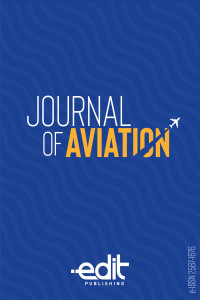TURBOJET MOTORLAR İÇİN PERFORMANS DEĞERLENDİRME PARAMETRELERİ
Uçak motoru, ekserji, enerji, gaz türbin, performans, turbojet
PERFORMANCE EVALUATION PARAMETERS FOR TURBOJET ENGINES
Aero-engine, Exergy, Energy, Gas turbine, Performance,
___
- Çoban, K., Çolpan, C.Ö., Karakoç, T.H., (2016). Bir Helikopter Motorunun Enerji ve Ekserji Analizi. Sürdürülebilir Havacılık Araştırmaları Dergisi, 1, 27-39.
- Ekici, S., Altuntas, O., Açıkkalp, E., Sogut, M. Z., Karakoc, T.H., (2016). Assessment of thermodynamic performance and exergetic sustainability of turboprop engine using mixture of kerosene and methanol, International Journal of Exergy, 19, 295-314.
- El-Sayed, A.F., (2008). Aircraft propulsion and gas turbine engines. CRC Press.
- Gunston, B., (2006). The development of jet and turbine aero engines, 4th Ed., Haynes Publishing.
- Jiang, J., (2015). A factor decomposition analysis of transportation energy consumption and related policy implications, IATSS Research, 38, 142-148.
- Mattingly, J.D., (2006). Elements of propulsion: gas turbines and rockets. American Institute of Aeronautics and Astronautics Publication.
- Mendez, C. J., Parthasarathy, R.N., Gollahalli, S.R., (2014). Performance and emission characteristics of butanol/Jet A blends in a gas turbine engine, Applied Energy, 118, 135-140.
- Onal, O., Turan, O., (2016). Calculation and Comparison of a Turbofan Engine Performance Parameters with Various Definitions. International Journal of Mechanical, Aerospace, Industrial, Mechatronic and Manufacturing Engineering, 10, 1677-1681.
- Şöhret, Y., Dinç, A., Karakoç, T.H., (2015). Exergy analysis of a turbofan engine for an unmanned aerial vehicle during a surveillance mission, Energy, 93, 716-729.
- Şöhret, Y., Ekici, S., Altuntaş, Ö., Hepbasli, A., Karakoç, T. H., (2016). Exergy as a useful tool for the performance assessment of aircraft gas turbine engines: A key review, Progress in Aerospace Sciences, 83, 57-69.
- Şöhret, Y., Karakoç, T.H., (2014). Gaz Türbinli Uçak Motorlarının Termodinamik Modellenmesi, Bilecik Şeyh Edebali Üniversitesi Fen Bilimleri Dergisi, 1, 29-36.
- Şöhret, Y., Sogut, M. Z., Karakoc, T. H., Turan, O., 2016. Customised application of exergy analysis method to PW120A turboprop engine for performance evaluation, International Journal of Exergy, 20, 48-65.
- Turan, Ö., Karakoç, T. H., (2009). Ardyanmalı Ve Ayrık Akışlı Turbofanlarda Fan Basınç Oranı Ve Bypass Oranıyla Toplam Verimin Değişiminin İncelenmesi, Havacılık ve Uzay Teknolojileri Dergisi, 4, 67-76.
- Turan, Ö., Orhan, İ., Karakoç, T.H., (2008). Yüksek Bypasslı Turbofan Motorlarının Tasarım Noktası Analizleri, Havacılık ve Uzay Teknolojileri Dergisi, 3, 1-8.
- US EIA, (2016). International Energy Outlook 2016 With Projections to 2040, U.S. Energy Information Administration Press.
- Utlu, Z., Hepbaşlı, A., (2006). Assessment of the energy utilization efficiency in the Turkish transportation sector between 2000 and 2020 using energy and exergy analysis method, Energy Policy, 34, 1611-1618.
- Whittle, F., (1945). The first james clayton lecture: the early history of the whittle jet propulsion gas turbine, Proc. Inst. Mech. Eng., 152, 419–435.
- Yayın Aralığı: Yılda 3 Sayı
- Başlangıç: 2017
- Yayıncı: Vedat Veli ÇAY
Dönüştürücü Lider Özellikleri Taşıyan Emniyet Liderleri: Kavramsal Bir Çerçeve
Havayolu Sektöründe Elektronik Ağızdan Ağıza İletişime (eWOM) Yönelik Bir Derleme
TURBOJET MOTORLAR İÇİN PERFORMANS DEĞERLENDİRME PARAMETRELERİ
Selcuk EKİCİ, Yasin ŞÖHRET, Tahir Hikmet KARAKOÇ
HAVALİMANI TERMİNAL BİNALARINDA ISI YALITIMI VE ISICAMIN ENERJİ PERFORMANSINA ETKİSİ
